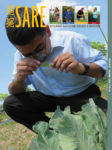Showing 21-30 of 78 results

Special Topics with Cover Crops and Soil Health
Organic and Specialty Crops Grazing Cover Crops Soil Health Policy Issues

Cover Crop Role in the Cropping System
Cover Crops and Nutrient Management Cover Crop Impacts on Diseases and Insects Cover Crops, Herbicides and Dealing with Herbicide-Resistant Weeds

Digging into Soil Health
Soil Health Principles Soil Health Testing and Practices Soil Biology and Organic Matter

Advanced Cover Cropping Insights from Farmer Experts
Great Plains Perspective Central Corn Belt Perspective Eastern Perspective

Basics of Cover Cropping
Introduction to Cover Crops Selecting and Establishing Cover Crops Terminating Cover Crops Plus Strategies for Planting a Cash Crop Following Cover Crops

Recordings of General Sessions
Opening remarks by Jane Hardisty (USDA-NRCS Indiana) with video message Bill Northey (Iowa Secretary of Agriculture) Keynote: Growing a Revolution - Bringing Our Soil Back to Life, by David Montgomery (University of Washington) Farmer panel: Experiences with Cover Crops and Soil Health, with Dan DeSutter (Ind.), Trey Hill (Md.) and Jimmy Emmons (Okla.) Top 10 Ways Cover Crops Build Soil Health, by Rob Myers (North Central SARE) Plenary session: Carbonomics, by Keith Berns (Neb. farmer and Green Cover Seed)

Cover Crops for Soil Health Workshop
All session recordings and slide presentations from this three-day professional development workshop are available online. Hosted by Northeast SARE and Delaware State University in March 2016, this event addressed the latest research on the benefits and successful management of cover crops in grain, vegetable and animal production systems.
Cover Crop Cocktails
Mitch Hunter (Penn State University) discusses the principles of how to assemble different cover crop species into a successful cocktail based on farm management objectives, crop rotation restraints, and which cover crop species traits are complementary.

Cover Crop Innovators Video Series
Find short video profiles of farmers around the country who are using cover crops on their land.

2015/2016 Report from the Field
Read about SARE-funded work in the areas of sustainable dairy cropping systems, soil health assessments, nutrient management, cover crops, beginning farmers, pollinators, technical assistance programs for women farmers, and more. This edition includes highlights of projects funded through the graduate student program, and the highly regarded Sustainable Agriculture Fellowship, a professional development program coordinated by SARE and NACAA.